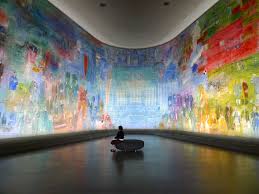VITEBSK ART SCHOOL (part 3)
 The circle of sources covering this time in the biography of the master is mainly identified and studied, therefore all sorts of new information and facts are so rare and valuable. Vitebsk teacher Valentin Karlovich Seilert in the late 1910s visited Pan, and in 1920-1922. studied in Witsvomas with K. Malevich. In his memoirs, he cites an interesting episode dating back to 1919. “Once I once came to Yuri Moiseevich. He had none of his students at that time. I went straight to him in his personal little workshop. I went there, and there they sat on the sofa, Yuri Moiseevich sat, and there was Chagall. Chagall in the corner near the window set his canvas. And then they sat, therefore, and discussed, because Chagall listened to Pan’s opinion, just like a diligent student, with respect to his teacher. But despite this, he, of course, continued his line of behavior. And there I just saw and heard a conversation. There it was the following. The head, bulging eye, and part of the skull were removed. Here in these convolutions a goat, a haystack and a hedge were painted. Everything, nothing more. A goat standing by a haystack and wondering whether to separate a piece of hay, or rather a piece of hay, to chew or not. And now Yuri Moiseevich says: “Why did you draw such a huge eye?” And Chagall answered him: “Yes, the eye of a person, if removed, is a huge ball. But we only see it a little between the squinted eyelids. ”
The circle of sources covering this time in the biography of the master is mainly identified and studied, therefore all sorts of new information and facts are so rare and valuable. Vitebsk teacher Valentin Karlovich Seilert in the late 1910s visited Pan, and in 1920-1922. studied in Witsvomas with K. Malevich. In his memoirs, he cites an interesting episode dating back to 1919. “Once I once came to Yuri Moiseevich. He had none of his students at that time. I went straight to him in his personal little workshop. I went there, and there they sat on the sofa, Yuri Moiseevich sat, and there was Chagall. Chagall in the corner near the window set his canvas. And then they sat, therefore, and discussed, because Chagall listened to Pan’s opinion, just like a diligent student, with respect to his teacher. But despite this, he, of course, continued his line of behavior. And there I just saw and heard a conversation. There it was the following. The head, bulging eye, and part of the skull were removed. Here in these convolutions a goat, a haystack and a hedge were painted. Everything, nothing more. A goat standing by a haystack and wondering whether to separate a piece of hay, or rather a piece of hay, to chew or not. And now Yuri Moiseevich says: “Why did you draw such a huge eye?” And Chagall answered him: “Yes, the eye of a person, if removed, is a huge ball. But we only see it a little between the squinted eyelids. ”
“Well, why did you draw these brains?”
“But what about a goat looking with its eye, and what it sees is fixed in the brain, because the eye does not see anything by itself.”
I gave some comrades this reminder. I know where this canvas could get lost, disappear. The fact is that Chagall often kept his canvases in cabinets built into workshops. There, as you climb the stairs to the second floor, there was a blank wall on the left. These were built-in wardrobes, and then went the semi-circular lobby and three doors to the workshops of Ermolaeva, Malevich and Lissitzky. So, in these cabinets the works were stored, firstly, students the best works and teachers. And there were many canvases of Chagall. We, freshmen, had no canvas, climbed there and stole the canvases. Apparently, many canvases were shabby. It is likely that this canvas was gone there. ”
The formation of the Vitebsk Folk Art School is associated with the name of Mstislav Valerianovich Dobuzhinsky, but so far the “Vitebsk period” of his life has a lot of white spots. He was a well-established artist-teacher whose pedagogical activity began at the end of 1906 in St. Petersburg, where he, together with L. Bakst (painting), led the drawing class at the private art school of E. Zvantseva. One of the students of the school in 1908 was Chagall. It seems likely that Dobuzhinsky arrived in Vitebsk at the invitation of Chagall. On behalf of the Department of Fine Arts under the Commissariat of the North-Western Regions, Dobuzhensky helped Chagall organize a folk art school, where for some time he was the director and director of the workshop. Dobuzhinsky’s stay in Vitebsk was short-lived. The artist’s family remained in Petrograd, and already at the end of January 1919, Dobuzhinsky left his job at the school.
The Vitebsk period in the work of this master was marked by the creation of a number of subtle, expressive watercolors and drawings with landscapes of the city, as well as sketches of scenery for the meeting dedicated to the memory of K. Liebknecht in the city theater and the amateur performance of students of the public school (January 1919).
It is interesting that later, in 1923, the artist performed three autolithographs: “Vitebsk. Sign “,” Vitebsk. Staircase “and” Vitebsk. Circus ”- all winter landscapes, obviously, according to the sketches of 1918-1919, because no evidence was found of the master’s arrival in Vitebsk after 1919. And one more riddle. In his memoirs, Dobuzhinsky only once mentions the casual name of Chagall and does not at all recall the Vitebsk art school. At the invitation of Chagall in May 1919, Lazar Markovich Lisitsky (1890-1941) came from Moscow to teach the basics of architecture, graphics and printing. Vitebsk was an important milestone in the creative biography of L. Lisitsky. Arriving there and later inviting Malevich to Vitebsk, “Lissitzky finds himself in a difficult ethical situation of choosing between his teacher Chagall and Malevich, the leader of radically-minded artistic youth. Taking the side of Malevich, Lissitzky becomes his follower, adherent and experiences a powerful impulse of influence of the Suprematist concept. ”
Perceiving Malevich’s Suprematism as the only possible world order system, the artist enriched it by giving Suprematism a three-dimensional interpretation in his experimental projects “PROUNAH” (“new approval projects”). Combining the laws of the Suprematist plane with the laws of constructive construction of forms and using the experience of architectural design, Lissitzky began to develop problems of the spatial organization of the city of the future. The famous propaganda poster of the master, “Beat the White with the Red Wedge” (1920), was also created here.




